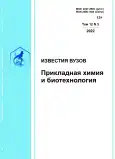UV irradiation testing of biodiesel from the Alhagi oil and diesel-biodiesel mixtures
- Authors: Guliyeva S.G.1, Mamedov I.G.1
-
Affiliations:
- Baku State University
- Issue: Vol 12, No 3 (2022)
- Pages: 455-461
- Section: Chemical technology
- URL: https://journals.rcsi.science/2227-2925/article/view/301194
- DOI: https://doi.org/10.21285/2227-2925-2022-12-3-455-461
- ID: 301194
Cite item
Full Text
Abstract
Keywords
About the authors
S. G. Guliyeva
Baku State University
Email: abdurahmanlisalatin@gmail.com
I. G. Mamedov
Baku State University
Email: bsu.nmrlab@mail.ru
References
- Mamedov I., Huseynova S., Javadova O., Azimova N., Huseynova R., Gasimova S. Testing of pine oil and glycerol ketal as components of B10 fuel blend. Energy, Environment and Storage. 2010;11:11-14.
- Mamedov I. G., Javadova O. N., Asimova N. V. Preparation of diesel fuel blends and study of their physical properties. Izvestiya Vuzov. Prikladnaya Khimiya i Biotekhnologiya = Proceedings of Universities. Applied Chemistry and Biotechnology. 2020;10(2):332-338. https://doi.org/10.21285/2227-2925-2020-10-2-332-338.
- Janaun J., Ellis N. Perspectives on biodiesel as a sustainable fuel. Renewable and Sustainable Energy Reviews. 2010;14(4):1312-1320. https://doi.org/10.1016/j.rser.2009.12.011.
- Rafał J., Kołomański K., Wądrzyk M., Lewandowski M., Dudek M., Suwała W., et al. Degradation of petroleum diesel fuel accelerated by UV irirradiation: the impact of ageing on chemical composition and selected physicochemical properties. E3S Web of Conferences. 2019;108:1-14. https://doi.org/10.1051/e3sconf/201910802003.
- Gad S. C. Diesel Fuel. Encyclopedia of Toxicology. 2014;1:115-118.
- Andrea P., Claudia D., Elke Z. UV irradiation of natural organic matter (NOM): impact on organic carbon and bacteria. Aquatic Sciences. 2012;74(3):443-454. https://doi.org/10.1007/s00027-011-0239-y.
- Bouilly J., Mohammadi A., Iida Y., Hashimoto H., Geivanidis S., Samaras Z. Biodiesel stability and its effects on diesel fuel injection equipment. Search Technical Papers. 2012;17:2688-3627. https://doi.org/10.4271/2012-01-0860.
- Zhang H., Jin D., Zhao X. J. UV Induced degradation of crude oil in polluted water based on analysis of environmental materials. Advanced Materials Research. 2012;534:333-336. https://doi.org/10.4028/www.scientific.net/AMR.534.333.
- Chang S. H. Diesel fuel analysis. Encyclopedia of Analytical Chemistry: Applications, Theory and Instrumentation. 2002;9:6613-6622. https://doi.org/10.1002/9780470027318.a1806.
- Emad Y., Raghad H. Photodegradation and photostabilization of polymers, especially polystyrene: review. Springer Plus. 2013;398(2):1-32. https://doi.org/10.1186/2193-1801-2-398.
- Richard F. L. Photo-oxidation and photo-toxicity of crude and refined oils. Spill Science & Technology Bulletin. 2003;8:157-162. https://doi.org/10.1016/S1353-2561(03)00015-X.
- Silva C. W., Castro M. P. P., Perez V. H., Machado F. A., Mota L., Sthel M. S. Thermal degradation of ethanolic biodiesel: physicochemical and thermal properties evaluation. Energy. 2016;114:1093-1099. https://doi.org/10.1016/j.energy.2016.08.052.
- Denisov E. T., Tumanov V. E. Estimation of the bond dissociation energies from the kinetic characteristics of liquid-phase radical reactions. Russian Chemical Reviews. 2005;74(9):825-858. https://doi.org/10.1070/RC2005v074n09ABEH001177.
- Prince R. C., Lessard R. R. Crude oil releases to the environment: natural fate and remediation options. Encyclopedia of Energy. 2004;1:727-736.
- Zodiatis G., Lardner R., Spanoudaki K., Sofianos S., Radhakrishnan H., Coppini G. et al. Operational oil spill modelling assessments. In: Marine Hydrocarbon Spill Assessments. 2021; p. 145-197. https://doi.org/10.1016/B978-0-12-819354-9.00010-7.
- Bouas-Laurent H., Castellanb A., Desvergnea J.-P., Lapouyade R. Photodimerization of anthracenes in fluid solution: structural aspects. Chemical Society Reviews. 2000;29(1):43-55. https://doi.org/10.1039/A801821I.
- Lennartson A., Roffey A., Moth-Poulsen K. Designing photoswitches for molecular solar thermal energy storage. Tetrahedron Letters. 2015;56:1457-1465.
- McConkey B. J., Hewitt L. M., Dixon D. G., Greenberg B. M. Natural sunlight induced photooxidation of naphthalene in aqueous solution. Water, Air, and Soil Pollution. 2002;136:347-359. https://doi.org/10.1023/A:1015223806182.
- Peter P. F., Qingsu X., Xin S., Hongtao Yu. Phototoxicity and environmental transformation of polycyclic aromatic hydrocarbons (PAHs) — light-induced reactive oxygen species, lipid peroxidation, and DNA damage. Journal of Environmental Science and Health. Part C, Environmental Carcinogenesis & Ecotoxicology Reviews. 2012;30(1):1-41. https://doi.org/10.1080/10590501.2012.653887.
- Roberts A. P., Alloy M. M., Oris J. T. Review of the photo-induced toxicity of environmental contaminants. Comparative Biochemistry and Physiology. Part C: Toxicology & Pharmacology. 2017;191:160-167. https://doi.org/10.1016/j.cbpc.2016.10.005.
- Richard F. L. Photo-oxidation and photo-toxicity of crude and refined oils. Spill Science & Technology Bulletin. 2003;8:157-162. https://doi.org/10.1016/S1353-2561(03)00015-X.
- Shankar R., Shim W. J., An J. G., Yim U. H. A practical review on photooxidation of crude oil: laboratory lamp setup and factors affecting it. Water Research. 2015;68:304-315. https://doi.org/10.1016/j.watres.2014.10.012.
- Feng Y.-L., Nandy J. P., Hou Y., Breton F., Lau B., Zhang J., et al. UV Light induced transformation of 1-methylnaphthalene in the presence of air and its implications for contaminants research. Journal of Environmental Protection. 2012;3(11):1519-1531. https://doi.org/10.4236/jep.2012.311168.
- Fathi-Achachlouei B., Azadmard-Damirchi S. Milk thistle seed oil constituents from different varieties grown in Iran. Journal of the American Oil Chemists’ Society. 2009;86(7):643-649. https://doi.org/10.1007/s11746-009-1399-y.
- McCormick R. L., Westbrook S. R. Storage stability of biodiesel and biodiesel blends. Energy Fuels. 2010;24:690-698. https://doi.org/10.1021/ef900878u.
- Christensen E. D., McCormick R. L. Long-term storage stability of biodiesel and biodiesel blends. Fuel Processing Technology. 2014;128:339-348. https://doi.org/10.1016/j.fuproc.2014.07.045.
- Bruna E. A., de Rezende D. B., Pasa V. Aging and stability evaluation of diesel/biodiesel blends stored in amber polyethylene bottles under different humidity conditions. Fuel. 2020;279:118289. https://doi.org/10.1016/j.fuel.2020.118289.
Supplementary files









